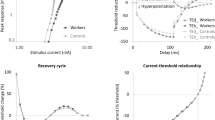Abstract
Objectives
The assessment of the neurotoxic effect of arsenic (As) and its inorganic compounds is still the subject of interest due to a growing As application in a large array of technologies and the need to constantly verify the principles of prevention and technological parameters. The aim of this study was to determine the status of the nervous system (NS) in workers exposed to As at concentrations exceeding hygiene standards (Threshold Limit Values (TLV) − 10 μg/m3, Biological Exposure Index (BEI) − 35 μg/l) and to analyze the relationship between the NS functional state, species of As in urine and As levels in the workplace air.
Material and Methods
The study group comprised 21 men (mean age: 47.43±7.59) employed in a copper smelting factory (mean duration of employment: 22.29±11.09). The control group comprised 16 men, matched by age and work shifts. Arsenic levels in the workplace air (As-A) ranged from 0.7 to 92.3 μg/m3; (M = 25.18±28.83). The concentration of total arsenic in urine (Astot-U) ranged from 17.35 to 434.68 μg/l (M = 86.82±86.6).
Results
Syndrome of peripheral nervous system (PNS) was manifested by extremity fatigue (28.6%), extremity pain (33.3%) and paresthesia in the lower extremities (33.3%), as well as by neuropathy-type mini-symptoms (23.8%). Electroneurographic (ENeG) tests of peroneal nerves showed significantly decreased response amplitude with normal values of motor conduction velocity (MCV). Stimulation of sural nerves revealed a significantly slowed sensory conduction velocity (SCV) and decreased sensory potential amplitude. Neurophysiological parameters and the results of biological and environmental monitoring showed a relationship between Astot, AsIII (trivalent arsenic), the sum of iAs (AsIII+AsV (pentavalent arsenic))+MMA (monomethylarsonic acid) concentration in urine and As levels in the air.
Conclusions
The results of the study demonstrate that occupational exposure to inorganic arsenic levels exceeding hygiene standards (TLV, BEI) generates disorders typical of peripheral neuropathy.
Similar content being viewed by others
References
World Health Organization. IPCS: Environmental health criteria 18: Arsenic. Geneva: WHO; 1981.
Kapaj S, Peterson H, Liber K, Bhattacharya P. Human health effects from arsenic poisoning — A review. J Environ Sci Health Part A. 2006;41(10):2399–2428.
Sitarek K, Szadkowska-Stańczyk I, Szymczak W. [Arsenic and inorganic arsenic compounds]. In: [Guidelines assess health risk carcinogen]. Łódź: Nofer Institute of Occupational Medicine; 2003. p. 5–42. Polish.
Lozeron P, Trocello JM, Kubis N. Acquired neuropathies. J Neurol. 2013;260(9):2433–2440, http://dx.doi.org/10.1007/s00415-013-6994-z.
Blom S, Lagerkvist B, Linderholm H. Arsenic exposure to smelter workers. Clinical and neurophysiological studies. Scand J Work Environ Health. 1985;11:265–269, http://dx.doi.org/10.5271/sjweh.2227.
Lagerkvist BJ, Zetterland B. Assessment of exposure to arsenic among smelter workers: A five year follow-up. Am J Ind Med. 1994;25:477–488, http://dx.doi.org/10.1002/ajim.4700250403.
Feldman RG, Niles CA, Kelly-Hayes M, Sax DS, Dixon WJ, Thompson DJ, et al. Peripheral neuropathy in arsenic smelter workers. Neurology. 1979;29:939–945, http://dx.doi.org/10.1212/WNL.29.7.939.
Lilis R, Valciukas JA, Weber JP, Malkin J. Effects of low-level lead and arsenic exposure on copper smelter workers. Arch Environ Health. 1985;40(1):38–47, http://dx.doi.org/10.1080/00039896.1985.10545887.
Langauer-Lewowicka H, Zając-Nędza M. [Peripheral nervous system in workers exposed to lead, copper and zinc]. Med Pr. 1990;41(5):293–298. Polish.
Araki S, Murata K, Uchida E, Aono H, Ozawa H. Radial and median nerve conduction velocities in workers exposed to lead, copper and zinc. A follow-up study for 2 years. Environ Res. 1993;61:308–316, http://dx.doi.org/10.1006/enrs.1993.1075.
Jakubowski M. [Arsenic and inorganic arsenic compounds]. In: Jakubowski M, editor. [Biological monitoring of environmental exposure to chemical agents]. Łódź: Nofer Institute of Occupational Medicine; 1997. p. 123–134. Polish.
Jakubowski M. [Arsenic, elemental and inorganic compounds — as As]. Podst Met Oceny Srodow Pr. 2000;1(23): 23–55. Polish.
Drozdowski W. [Electroneurography technics]. In: Emeryk-Szajewska B, Niewiadomska-Wolska M, editors. [Clinical neurophysiology. Electromyography and electroneurography]. Kraków: Medycyna Praktyczna; 2008. p. 79–89. Polish.
Langauer-Lewowicka H, Zając-Nędza M. [Arsenic]. In: Marek K, editor. [Occupational diseases]. Warszawa: PZWL; 2001. p. 199–202. Polish.
Mathew L, Vale A, Adcok JE. Arsenical peripheral neuropathy. Pract Neurol. 2010;10(1):34–38, http://dx.doi.org/10.1136/jnnp.2009.201830.
Gluszcz-Zielińska A. [Occupational n-hexane neuropathy: Clinical and neurophysiological investigation]. Med Pr. 1999;50(1):31–36. Polish.
Murphy MJ, Lyon LW, Taylor JW. Subacute arsenic neuropathy: Clinical and electrophysiological observations. J Neurol Neurosurg Psychiatry. 1981;44:896–901, http://dx.doi.org/10.1136/jnnp.44.10.896.
Seppäläinen AM. Neurophysiological approaches to the detection of early neurotoxicity in humans. Crit Rev Toxicol. 1988;18(4):245–298, http://dx.doi.org/10.3109/10408448809037468.
Tseng HP, Wang YH, Wu MM, The HW, Chiou HY, Chen CJ. Association between chronic exposure to arsenic and slow nerve conduction velocity among adolescents in Taiwan. J Health Popul Nutr. 2006;24(2):182–189.
Langauer-Lewowicka H, Kazibutowska Z. [The value of multimodal evoked potentials in the assessment of neurotoxicity of combined exposure to Pb, Cu and Zn]. Neurol Neurochir Pol. 1991;25(6):715–719. Polish.
Pohl HR, Roney N, Abadin HG. Metal ions affecting the neurological system. Met Jons Life Sci. 2011;8:247–262.
Hałatek T, Sińczuk-Walczak H, Rabieh S, Wąsowicz W. Association between occupational exposure to arsenic and neurological, respiratory and renal effects. Toxicol Appl Pharmacol. 2009;239:193–199, http://dx.doi.org/10.1016/j.taap.2009.04.022.
Sińczuk-Walczak H, Szymczak M, Hałatek T. Effects of occupational exposure to arsenic on the nervous system: Clinical and neurophysiological studies. Int J Occup Med Environ Health. 2010;23(4):347–355, http://dx.doi.org/10.2478/v10001-010-0034-3.
Author information
Authors and Affiliations
Corresponding author
About this article
Cite this article
Sińczuk-Walczak, H., Janasik, B.M., Trzcinka-Ochocka, M. et al. Neurological and neurophysiological examinations of workers exposed to arsenic levels exceeding hygiene standards. IJOMEH 27, 1013–1025 (2014). https://doi.org/10.2478/s13382-014-0316-2
Received:
Accepted:
Published:
Issue Date:
DOI: https://doi.org/10.2478/s13382-014-0316-2




